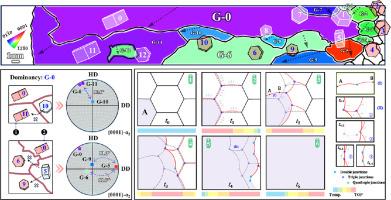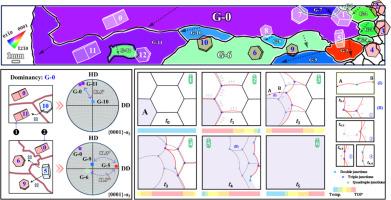定向退火TiAl合金的各向异性晶粒生长和高温变形:热区迁移速率和三维孪晶网络的作用
IF 9.3
1区 材料科学
Q1 MATERIALS SCIENCE, MULTIDISCIPLINARY
引用次数: 0
摘要
定向凝固制备了具有优异力学性能的PST TiAl合金;然而,工业可扩展性和过程稳定性方面的持续挑战阻碍了实际实现。本研究展示了柱状晶/单晶TiAl合金通过固态定向热处理的无坩埚加工,为高性能金属间化合物的工业生产提出了一条新的途径。通过先进的多尺度显微结构表征和原位晶界(GB)跟踪,我们发现热区(HZ)迁移速率的降低(VthermalVthermal=2 μms-1)通过曲率驱动动力学增强了α-GB迁移率,双GB结迁移速率的差异被GB耦合步骤的形成所补偿,产生了长度为38.8 mm、宽高比超过1的柱状结构。相反,加速的VthermalVthermal (8 μms-1)使α2/γ片层间距提高了90.8%,900℃抗拉强度提高了87.4 MPa,但塑性降低了48.1%。在2 μms-1温度下,γ片层(γ l)内存在三维孪晶网络,该网络由应力集中界面处的二次孪晶维持。这些发现建立了热处理参数、GB动力学和变形机制之间的定量关系,为设计具有平衡强度-塑性协同作用的高性能TiAl部件提供了重要见解。本文章由计算机程序翻译,如有差异,请以英文原文为准。


Tuning anisotropic grain growth and high-temperature deformation in TiAl alloys via directional annealing: role of hot zone migration rate and 3D twin networks
Directional solidification (DS) enables fabrication of polysynthetically twinned (PST) TiAl alloys with superior mechanical properties; yet persistent challenges in industrial scalability and process stability hinder practical implementation. This work demonstrates crucible-free processing of columnar-grained/single-crystal TiAl alloys through solid-state directional heat treatment, proposing a novel pathway for industrial production of high-performance intermetallics. Through advanced multi-scale microstructural characterization and in situ grain boundary (GB) tracking, we reveal that reduced hot zone (HZ) migration rates (=2 μms-1) enhance α-GB mobility via curvature-driven dynamics, with the disparity in migration rates across the double GB junctions being compensated by the formation of GB coupling steps, producing columnar structures with 38.8 mm length and aspect ratios exceeding unity. Conversely, accelerated (8 μms-1) refine α2/γ lamellar spacing by 90.8 %, elevating 900 °C tensile strength by 87.4 MPa but compromising ductility by 48.1 %. The remarkable ductility observed at 2 μms-1 is attributed to a three-dimensional twin network within the γ lamellae (γL), which is maintained by secondary twinning at stress-concentrated interfaces. These findings establish quantitative relationships between thermal processing parameters, GB kinetics, and deformation mechanisms, offering critical insights for designing high-performance TiAl components with balanced strength-ductility synergies.
求助全文
通过发布文献求助,成功后即可免费获取论文全文。
去求助
来源期刊

Acta Materialia
工程技术-材料科学:综合
CiteScore
16.10
自引率
8.50%
发文量
801
审稿时长
53 days
期刊介绍:
Acta Materialia serves as a platform for publishing full-length, original papers and commissioned overviews that contribute to a profound understanding of the correlation between the processing, structure, and properties of inorganic materials. The journal seeks papers with high impact potential or those that significantly propel the field forward. The scope includes the atomic and molecular arrangements, chemical and electronic structures, and microstructure of materials, focusing on their mechanical or functional behavior across all length scales, including nanostructures.
 求助内容:
求助内容: 应助结果提醒方式:
应助结果提醒方式:


